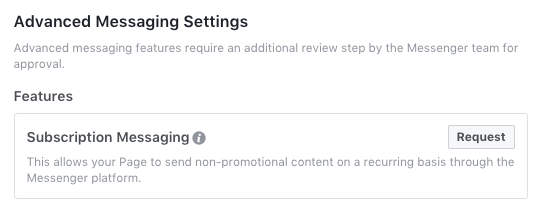Standard Messaging
The following is an overview of policies that apply to Messenger Platform integrations that use standard messaging. For complete policy details, see the Messenger Platform section of the Facebook Platform Policy.
24-Hour Messaging Window
Businesses and developers using the Send API have up to 24 hours to respond to a message sent by a person in Messenger when using standard messaging. A bot may also send one additional message after the 24-hour time limit has expired. The 24-hour limit is refreshed each time a person responds to a business through one of the eligible actions listed in Messenger Conversation Entry Points. This is commonly referred to as the '24 + 1 policy'.
For information on how you may be able to send messages outside the 24-hour messaging window, see the Tags documentation, and Sponsored Messages.
Usage Guidelines
The following guidelines apply to usage of the Send/Receive API for standard messaging:
- Integrations that provide live chat support are also subject to the 24-hour messaging window.
- Promotional content is allowed for standard messaging. Note that promotional content is not allowed for subscription messaging.
- For a business or developer to send a message to a person on Messenger, the person must initiate contact first. Examples of how contact is initiated include the person tapping the “Get Started” button in the welcome screen, tapping a "Send to Messenger" plugin, sending a message, etc.
- People continue to have the option to block or mute a conversation with a business or developer at any time.
Subscription Messaging (BETA)
Subscription messaging is allowed for specific use cases, and gives a business or developer the ability to send regular content to a person on Messenger. If the bot has the proper app permission, a person automatically opts-in to receive subscription messaging when they perform any action that begins a conversation.
Eligible Use Cases
- News: Integrations whose primary purpose is to inform people about recent or important events, or provide information in categories such as sports, finance, business, real estate, weather, traffic, politics, and entertainment.
- Productivity: Integrations whose primary purpose is to enable people to manage their personal productivity with tasks, such as managing calendar events, receiving reminders, and paying bills.
- Personal trackers: Integrations that enable people to receive and monitor information about themselves in categories such as fitness, health, wellness, and finance.
For complete information on Facebook Messenger Policy, please visit the Facebook Messenger Policy Page.
You will be able to continue to use Subscription Messaging until April 30th, 2019. After that date, you will need to apply for subscription messaging permission for EACH Fan page you wish to send Subscription Messages.
How do i apply to send subscription messages?
Page admins may access the subscription messaging request form by doing the following:
- Go to Page Settings > Messenger Platform
- Under 'Subscription Messaging' in the 'Advanced Messaging Settings' section, click the 'Request' button.

In the form, the Page admin will be asked to provide the following:
- A sample message and a brief description of how the bot will use subscription messaging.
- A short screencast that shows how people will start a conversation with the bot and examples of subscription messages that the bot will send.
- Which of the three eligible subscription messaging use cases applies to the bot.See below for eligible use cases.
- A confirmation that the bot will only send non-promotional content, and will abide by all Facebook Platform policies and community standards.
Here are some other Tips to keep in mind:
User authentication and opt-out:
a. Place any user authentication method in a clear and conspicuous location to ensure people consent to initiating message threads.
b. Don’t contact people in Messenger unless you, or the party to whom you are operating as a service provider, have the necessary consent to do so.
c. Messenger Opt-out: respect all requests (either on Messenger or off) by people to block, discontinue, or otherwise opt-out of your using Messenger to communicate with them.
Messenger Plugins:
a. Don't obscure, cover or hide elements of the plugins.
b. Ensure the Checkbox plugin is placed in close proximity to the button (ex: “purchase”, “submit”, “confirm”) that a person must click. Facebook™ recommends the checkbox plugin be placed above any button that triggers the checkbox plugin.
Watch the video below for more details and strategy on how to build your Bots and stay compliant with Facebook™ Policy.


